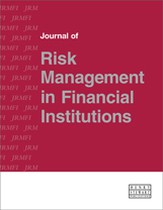Credit BuVaR: Asymmetric spread VaR with default
Abstract
A tradeable credit instrument shows two forms of credit risk — a continuous spread risk and a discontinuous default risk. The Basel market risk framework requires the two risks to be modelled separately for the purpose of regulatory capital but this gives rise to issues of risk aggregation. The author proposes a risk metric called credit bubble VaR (Cr. buVaR) that combines these dual risks under a common historical simulation value-at-risk (VaR) approach. By using a single model, Cr. buVaR bypasses the problem of risk aggregation. Credit risks can then be aggregated with market risk in a diversifiable manner. Cr. buVaR is also found to be forward-looking with respect to issuer credit default and is not procyclical. The model is motivated by evidence from the 2008 crisis that issuer defaults and spread movements exhibit asymmetry, and that defaults are always preceded by rapid spread widening. The method involves scaling the positive side of the return distribution of credit spreads in proportion to current spread levels. By drawing inferences from studies on the ‘credit spread puzzle’, it is deduced that the incremental loss of Cr. buVaR over spread VaR is due to default risk.
The full article is available to subscribers to the journal.
Author's Biography
Max Wong is the Head of VaR Model Testing at a UK bank and has 15 years of experience in the financial services industry. He has recently published a book entitled: ‘Bubble value at risk: Extremistan and Procyclicality’ (Immanuel Consulting, 2011). Prior to this, Max has worked in other roles such as market strategist, futures trader and financial analyst at various financial institutions. He was an ‘open outcry’ pit trader during the Asian crisis in 1997 and a quantity risk manager during the credit crisis in 2007. Max holds a BSc degree in physics and an MSc degree in financial engineering. His current research is in the area of financial regulatory reform and innovative risk management.
Citation
Wong, Max (2011, December 1). Credit BuVaR: Asymmetric spread VaR with default. In the Journal of Risk Management in Financial Institutions, Volume 5, Issue 1. https://doi.org/10.69554/MXGZ9946.Publications LLP
